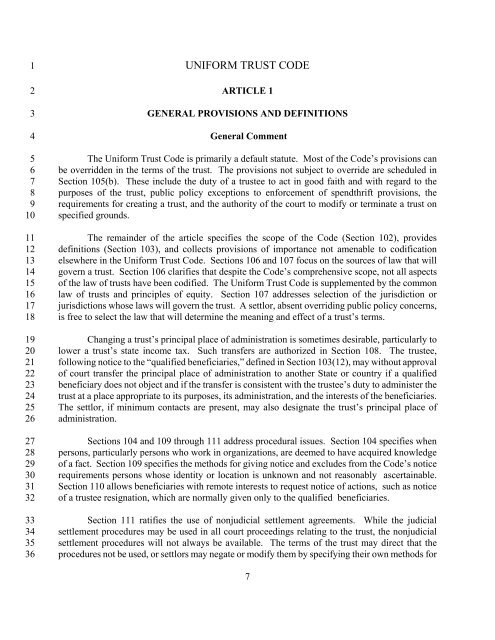uniform trust code - Kansas Judicial Branch
uniform trust code - Kansas Judicial Branch
uniform trust code - Kansas Judicial Branch
Create successful ePaper yourself
Turn your PDF publications into a flip-book with our unique Google optimized e-Paper software.
1<br />
2<br />
3<br />
4<br />
5<br />
6<br />
7<br />
8<br />
9<br />
10<br />
11<br />
12<br />
13<br />
14<br />
15<br />
16<br />
17<br />
18<br />
19<br />
20<br />
21<br />
22<br />
23<br />
24<br />
25<br />
26<br />
27<br />
28<br />
29<br />
30<br />
31<br />
32<br />
33<br />
34<br />
35<br />
36<br />
UNIFORM TRUST CODE<br />
ARTICLE 1<br />
GENERAL PROVISIONS AND DEFINITIONS<br />
General Comment<br />
The Uniform Trust Code is primarily a default statute. Most of the Code’s provisions can<br />
be overridden in the terms of the <strong>trust</strong>. The provisions not subject to override are scheduled in<br />
Section 105(b). These include the duty of a <strong>trust</strong>ee to act in good faith and with regard to the<br />
purposes of the <strong>trust</strong>, public policy exceptions to enforcement of spendthrift provisions, the<br />
requirements for creating a <strong>trust</strong>, and the authority of the court to modify or terminate a <strong>trust</strong> on<br />
specified grounds.<br />
The remainder of the article specifies the scope of the Code (Section 102), provides<br />
definitions (Section 103), and collects provisions of importance not amenable to codification<br />
elsewhere in the Uniform Trust Code. Sections 106 and 107 focus on the sources of law that will<br />
govern a <strong>trust</strong>. Section 106 clarifies that despite the Code’s comprehensive scope, not all aspects<br />
of the law of <strong>trust</strong>s have been codified. The Uniform Trust Code is supplemented by the common<br />
law of <strong>trust</strong>s and principles of equity. Section 107 addresses selection of the jurisdiction or<br />
jurisdictions whose laws will govern the <strong>trust</strong>. A settlor, absent overriding public policy concerns,<br />
is free to select the law that will determine the meaning and effect of a <strong>trust</strong>’s terms.<br />
Changing a <strong>trust</strong>’s principal place of administration is sometimes desirable, particularly to<br />
lower a <strong>trust</strong>’s state income tax. Such transfers are authorized in Section 108. The <strong>trust</strong>ee,<br />
following notice to the “qualified beneficiaries,” defined in Section 103(12), may without approval<br />
of court transfer the principal place of administration to another State or country if a qualified<br />
beneficiary does not object and if the transfer is consistent with the <strong>trust</strong>ee’s duty to administer the<br />
<strong>trust</strong> at a place appropriate to its purposes, its administration, and the interests of the beneficiaries.<br />
The settlor, if minimum contacts are present, may also designate the <strong>trust</strong>’s principal place of<br />
administration.<br />
Sections 104 and 109 through 111 address procedural issues. Section 104 specifies when<br />
persons, particularly persons who work in organizations, are deemed to have acquired knowledge<br />
of a fact. Section 109 specifies the methods for giving notice and excludes from the Code’s notice<br />
requirements persons whose identity or location is unknown and not reasonably ascertainable.<br />
Section 110 allows beneficiaries with remote interests to request notice of actions, such as notice<br />
of a <strong>trust</strong>ee resignation, which are normally given only to the qualified beneficiaries.<br />
Section 111 ratifies the use of nonjudicial settlement agreements. While the judicial<br />
settlement procedures may be used in all court proceedings relating to the <strong>trust</strong>, the nonjudicial<br />
settlement procedures will not always be available. The terms of the <strong>trust</strong> may direct that the<br />
procedures not be used, or settlors may negate or modify them by specifying their own methods for<br />
7

















